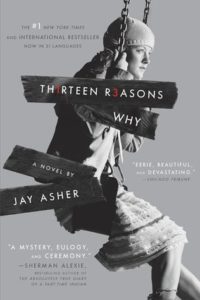 Asher, Jay. Thirteen Reasons Why
Asher, Jay. Thirteen Reasons Why
Penguin Random House, 2007
978–1–59514–188–0
Originally published in 2007, this book recently received renewed interest when streaming service Netflix made it into a series. In fact, that’s why I bought and read it.
The story comprises 13 cassette recordings left by teenager Hannah Baker for the people who contributed to her suicide. The novel is narrated by Clay Jensen, Hannah’s would-be boyfriend, as he progresses through the 13 tales.
I’m going to let you read the book or watch the series for the details of how teenage bullying and bad behavior led to Hannah’s suicide. In place of a book review, here is my reaction to it.
I finished the book with alarmingly mixed feelings about it. My edition, a tie-in with the Netflix series, contains an ending section titled “Between the Lines: Thirteen Questions for Jay Asher,” and I had to read that section to convince myself that Asher meant for this book to have a positive message.
Yes, the novel ends with Clay feeling hope when he insists on talking to Skye so that Skye will not feel driven toward suicide, as Hannah was. But before that he felt nearly overwhelming guilt:
You were not very clear with me … I didn’t know what you were going through, Hannah … I would have helped her if she’d only let me. I would have helped her because I want her to be alive (p. 280)
When Clay had tried to talk with Hannah, she pushed him away. These kids are 15 years old, at an age when they’re learning how to interact socially. And now, with so much concern over drugs, date rape, and slut shaming, we’re emphasizing that no means no. Is it fair, then, to expect an obviously caring character like Clay to force Hannah to do something, even just talk, against her will? Despite the book’s hopeful ending, which shows that Clay has learned from Hannah’s tape, I’m bothered that Clay has been made to shoulder so much self-blame for Hannah’s death:
How many times after the party did I stand right here, when Hannah was still alive, thinking my chances with her were over? Thinking I said or did something wrong. Too afraid to talk to her again. Too afraid to try. (p. 285)
I wish Asher had found some other way to demonstrate that we should all recognize and insist on trying to help people in crisis, even when they try to push us away.
I’m not objecting to reading about an emotionally sensitive issue like suicide. Rather, I’m concerned with part of the message that this book presents as a solution.
And I’ve decided not to watch the Netflix series.
© 2017 by Mary Daniels Brown
